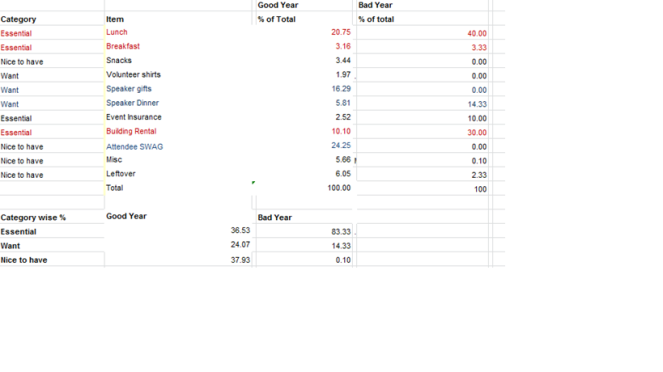We’ve been doing SQLSaturdays for eight years at Louisville now. We’ve had a quite a wide range of budgets depending on the year – a good year (our highest was 2013) and lowest, the first year we started, 2009.
As main organizer, handling the dollars and making sure I spend them right has been an interesting, learning experience for me. For the past two years I’ve had additional help from others on the organizing committee, but for a good six years it was just me doing it and figuring out the do’s and don’ts the hard way. Below is how I do it now, and I have got it down to a good formula that works most of the time.
I divide the revenue into two buckets: – 1 Predictable and 2 Non- predictable. Predictable revenue is what comes in two months before the event. That includes committed sponsors. So far, we have been lucky in getting two or more this way. Non- predictable revenue is what comes in closer to the event, includes last- minute sponsors and revenue based on pre-cons.
Expenses wise – I divide my expenses into the following three buckets.
1. Essentials – These – include event rental, event insurance, and food. Without these,we cannot run.the event. The predictable sponsor revenue goes towards this category of expenses.
2. Wants – After we pass survival, the second bucket of expenses comes in: – that includes speaker dinner, speaker gifts,volunteer shirts; printing of various event- related material like internal signage , event schedule, speaker and event feedback forms; speedpass for speakers;lanyards and nametags. Printing of materials does not cost much. Volunteer-shirts is something we do every year as they are popular not expensive either. The main costs here are speaker dinner and speaker gifts – how much is spent on them depends strongly on how well we are funded.
3. Nice-to- haves – This includes attendee swag/give aways,extra treats to eat (such as cake or ice cream), and reusable event inventory that we can store for future events. We have done lots of cool things in this category – especially with reusable stuff. Our stock includes signage (external to the building), extension cords, foldable garbage bins, raffle boxes, dollies, a laser printer and many smaller items like paper, duct tape, staplers, scissors, and so on. We have enough stuff to just walk in somewhere and set up any event at short notice.
So that said, what about some real numbers? Below is the percentage breakup I have for a good event (where we have had great funding), and a low- funded event.

It is interesting to see that essentials take up 80% of funding on a typical bad year. Needless to say that nice-to-have-es are are almost down to zero. The question this type of analysis helps me answer is:
What is the minimum $ needed to put up an event?
Every SQL Saturday organizer should absolutely know the answer to this, if not you are walking blind. To know it you have to focus on what are the costs of essentials – room rental and food Remember that both costs are driven by attendee count. For us in Louisville – it is seriously hard to find a free location any more. We don’t like to cut down on attendees as we have worked hard to build up that number and do not like disappointing them. I realize that there are events that can play with this number and reduce the number of attendees to support their funds, but I’d not like to do that unless am absolutely forced to. Finding a free location is also possible with smaller attendee counts, so that is not something to be ruled out entirely, but we’d like to keep that up as much as we can. With attendee count at 200-250, – the other numbers I focus on are as follows.
We have typically six tracks, with six timeslots, adding up to 36 speakers, ideally. For a short -funded event we can cut this down to four tracks with five timeslots, adding upto 20 speakers. This also saves us money on number of rooms rented. We can go from a buffet to a boxed lunch, that costs about 6$-8$ per head. Since 30-40% of people who eat are speakers/sponsors and volunteers, that can significantly reduce my costs too. Given that my costs add up to approx. $800 (rental + insurance) + $1800 (food) + $400$ extra = $3000$ to run a decent event (that includes lunch fees). With less money than that, I would think very hard about doing it. I can, if I find a free location which means even fewer rooms and consequently fewer attendees, but hopefully will not need to. This number gives me a lot of relief when it comes to what to expect by way of funding. It is the same math that goes into what is needed to pull off a pre-con too – if the attendee count does not add up to paying for rooms, lunch, and a minimum of 20% leftover, we typically cancel as it is not worth the costs.
My costs in the ‘want’ bucket are significantly lower with each year because of the reusable inventory swag we have built over years. I would strongly encourage all organizers to invest in this, especially when your funding is good. I do not deny that there is a storage cost that may be involved. We are fortunate to have a volunteer store it at her home for us – but this might be hard for some people. It does, however, help you make your event as mobile as possible without depending on specific locations, and also significantly cuts down on your costs, while keeping up the good appearance of a professionally run event.


